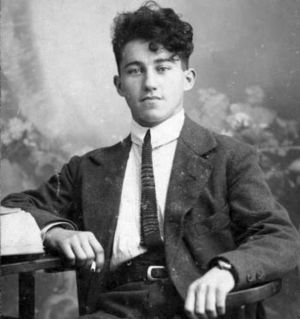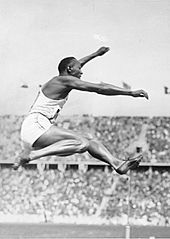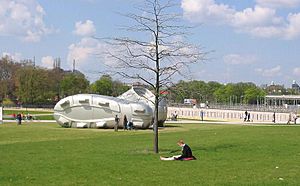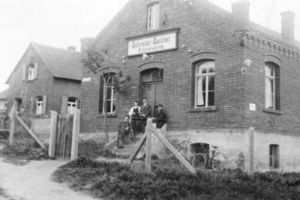Adolf Dassler facts for kids
Quick facts for kids
Adolf Dassler
|
|
|---|---|

Dassler at Age 15 in c. 1915
|
|
| Born | 3 November 1900 Herzogenaurach, German Empire
|
| Died | 6 September 1978 (aged 77) Herzogenaurach, West Germany
|
| Occupation | Founder of Adidas |
| Spouse(s) | Käthe (née Martz) (17 July 1917 – 31 December 1984) |
| Parent(s) | Christoph Dassler (father) Pauline Dassler (mother) |
| Relatives | Fritz Dassler (brother) Marie (sister) Rudolf Dassler (brother) Horst Dassler (son) Armin Dassler (nephew) |
Adolf "Adi" Dassler (born November 3, 1900 – died September 6, 1978) was a German shoemaker and inventor. He is famous for founding the sportswear company Adidas. Adi was also the younger brother of Rudolf Dassler, who started the rival company Puma.
Dassler was a true innovator in designing athletic shoes. He was one of the first to get famous athletes to wear and promote his products. Thanks to his ideas, Adidas grew into the world's largest maker of sportswear and equipment. By the time he passed away, Adidas had 17 factories and made a billion German marks in sales each year.
Contents
Life
Starting the Dassler Brothers Shoe Factory (1918–1945)
Adi Dassler began his business by repairing shoes in his hometown. After World War I, it was hard to find materials or money to start a factory. So, he got creative. He used old army helmets and bread bags for leather soles. Parachutes even provided silk for slippers.
Adi was very good at making his own tools. He once used a stationary bicycle to power a leather machine. His main goal was to design special shoes for different sports. He made some of the first spiked running shoes. He also tried out many materials, like shark skin and kangaroo leather, to make shoes that were both strong and light. His wife, Käthe Dassler, later said that designing shoes was his passion, not just his job.
Adi's brother, Rudolf, joined the business on July 1, 1923. With help from a friend's smithy for spikes, they officially registered their company. It was called "Dassler Brothers Sports Shoe Factory." They started in a small workshop that used to be a washroom. By 1925, they were making leather football boots with nailed studs and track shoes with handmade spikes.
Their business grew from a small local factory to an international company. This happened for two main reasons. First, Josef Waitzer, a former Olympian and German Olympic track-and-field coach, became interested in their work. He visited their factory and became a friend and advisor. This connection helped Adi meet athletes at the 1936 Berlin Olympics. Even earlier, at the 1928 Amsterdam games, athletes were using Dassler shoes. For example, Lina Radke, a German runner, won a gold medal in 1928 wearing their track shoes.
The second reason for their growth was the importance of sports in Germany during the 1930s. The Dassler brothers saw how their business could benefit from this. Both Adi and Rudolf joined the Nazi Party in 1933. Adi also became a coach and supplier for clubs in the Hitler Youth movement in 1935.
In the early 1930s, Adi studied shoe design. He met Käthe Martz, and they married on March 17, 1934. Käthe was different from Rudolf's wife, and she often had disagreements with Adi's family. Rudolf later blamed Käthe for problems between the brothers. Adi and Käthe had five children: Horst, Inge, Karin, Brigit, and Sigrid.

Adi saw the 1936 Berlin Olympics as a huge chance to show his shoes to the world. He made sure most German athletes wore Dassler shoes. But he especially wanted to reach Jesse Owens, the American track-and-field star. Adi met Owens and offered him his shoes. Owens wore them when he won four gold medals. This included beating his own record in the long jump.
The connection with Jesse Owens was very important for the company. It made them famous around the world and boosted sales. It even saved their factory later. When American soldiers found out that Owens' Olympic shoes were made there, they decided not to destroy the factory. Many soldiers even became customers. Orders for basketball, baseball, and hockey shoes helped the Dasslers become a worldwide success.
When World War II started, the factory's focus changed. It was allowed to operate, but production was limited. In 1940, Adi was called to join the army. But he was released in 1941 because his work at the factory was considered essential. Rudolf, who had served in World War I, was drafted in 1943.
During the war, the factory partly made military equipment. It was hard to get supplies and workers. Adi even asked to use Soviet prisoners of war to help with production. The war also made the disagreements between Rudolf and Adi worse. They lived in the same house with their families, and tensions grew. Rudolf was angry that Adi was released from the army. He also made decisions that hurt their sister Marie's family.
In 1943, the factory stopped making shoes and started making parts for a weapon called the Panzerschreck. This was a shoulder-fired weapon used against tanks. The factory welded parts for these weapons. Rudolf, still in the army, tried to get the factory to make army boots instead, but his plan failed. He later fled the army and returned home.
When American troops arrived in Herzogenaurach, they almost destroyed the Dassler factory. But Käthe quickly told them it was just a sports shoe factory. The troops spared the plant and took over the family home. After the war, the brothers' past connections to the Nazi Party caused a huge rift between them. Each tried to protect himself, leading to an unbreakable split.
The Split and Founding Adidas (1946–1947)
After the war, Rudolf was arrested by American authorities. He was suspected of working for a secret service group. He was held in an internment camp for about a year. Rudolf tried to prove he didn't willingly help the Nazis. Meanwhile, Adi also had to go through a denazification process. He was first seen as a serious Nazi offender. But after many people spoke up for him, his status was changed. He was allowed to manage the company again.
Rudolf believed Adi had reported him to the authorities. This, along with their arguments during Adi's appeal, made it impossible for them to work together. The family was completely divided. Their mother sided with Rudolf, while their sister Marie sided with Adi.
Rudolf and his family moved across the river. He took over the second factory of the Dassler firm. Adi kept the first factory and the family home. They divided all the company's assets one by one. After they split their businesses, the brothers never spoke to each other again.
After the war, Adi's company faced challenges again, like finding materials. But the American authorities wanted to help the economy recover. Adi used rubber from old fuel tanks and canvas from tents to make shoes. He managed the business, even under supervision for a few months, until the final split from his brother in 1948.

When the company split, employees chose which brother they wanted to work for. Most of the sales staff went with Rudolf. But almost all the technicians and product developers stayed with Adi. Adi ended up with nearly two-thirds of the employees. His wife Käthe and her sister Marianne helped with the business.
Adi wanted his shoes to have a unique look. He decided to color the reinforcement straps on the sides of the shoes differently. He tried different numbers of stripes and chose three. The "three stripes" became the special mark of Adidas shoes. In March 1949, he registered this logo as the company's trademark.
For the company name, Adi wanted to combine his nickname "Adi" with his last name "Dassler." He thought of "Addas," but that name was already used by a children's shoe company. So, on August 18, 1949, he added an "i" to make it "Adidas." The company became known as Adolf Dassler adidas Schuhfabrik.
Adidas' Success (1948–1978)
Sepp Herberger, the coach of the German national football team, had worked with the Dassler brothers before their split. After the breakup, he first sided with Puma. But after a disagreement with Rudolf, Herberger switched to Adidas.
Adi was quiet and always willing to learn what football players needed. He was also more innovative than his brother. Herberger wanted Germany to be a top football team. He worked with Adi, who became a regular part of the national team's group. Adi would even adjust players' shoes during games.

West Germany was not allowed to play in the 1950 World Cup. So, they prepared for the 1954 matches in Switzerland. By then, Adidas's football boots were much lighter than older designs. At the World Cup, Adi had a secret weapon: "screw-in studs." Unlike traditional boots with fixed studs, Adi's shoes allowed players to change the length of their spikes. This depended on how muddy the field was.
In the final match, West Germany played against the strong Hungarian team. It started to rain, which was good for West Germany because their best player, Fritz Walter, played well in muddy conditions. As the field got worse, Herberger famously told Adi, "Adi, screw them on." The longer spikes gave the West German players better grip than the Hungarians, whose boots were heavy with mud. West Germany made a comeback and won 3-2. This became known as the "Miracle in Bern." Herberger publicly said that Dassler was key to the win. Adidas became very famous in West Germany and around the world. People watching the first televised World Cup final saw this amazing new shoe.
Personal Life
Adolf Dassler was married to Käthe until he passed away from heart failure in 1978. They had five children. In 1973, their son Horst Dassler started Arena, a company that makes swimming equipment. Käthe Dassler died on December 31, 1984.
After Adolf Dassler
After Adolf Dassler's death, his son Horst and his wife, Käthe, took over running Adidas. Horst passed away on April 11, 1987.
Adidas became a private company in 1989. It remained a family business until it offered shares to the public in 1995. The last family member to work for Adidas was Frank Dassler, Rudolf's grandson. He was head of the legal department and left in 2018.
In 2006, a sculpture of Adolf Dassler was put up in the Adi Dassler Stadium in Herzogenaurach. It was made by the artist Josef Tabachnyk.
See also
 In Spanish: Adolf Dassler para niños
In Spanish: Adolf Dassler para niños
- Dassler brothers feud
- German inventors and discoverers


